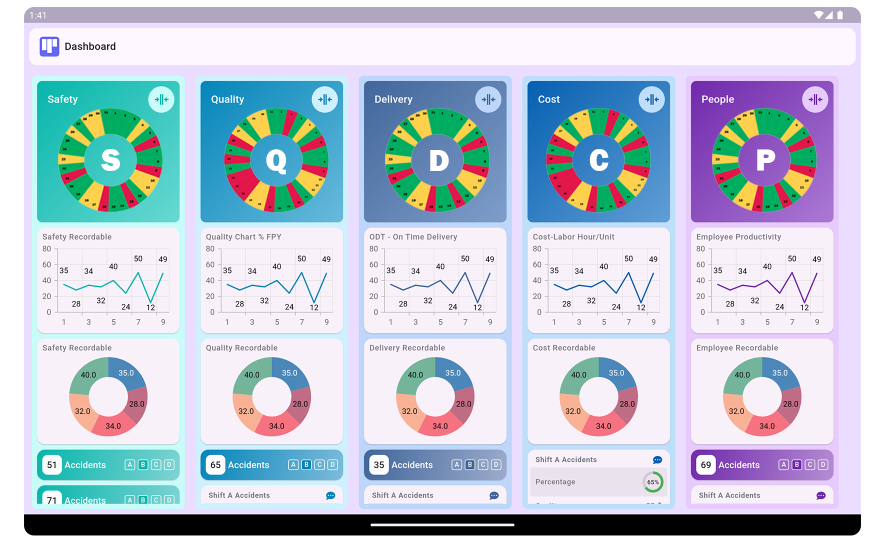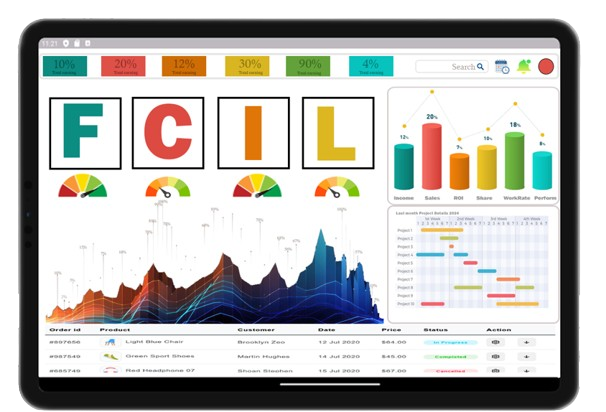The Balanced Scorecard (BSC) is a strategic management tool designed to help organizations align business activities with their vision and strategy. By offering a structured approach to tracking performance across key areas, the Balanced Scorecard provides insights that guide decision-making and support goal achievement. The tool enables leaders to focus on both financial and non-financial metrics, ensuring a balanced view of organizational health.

What is the Balanced Scorecard in Strategic Management?
The Balanced Scorecard is a strategic management framework that provides a comprehensive view of an organization’s performance. Traditionally, businesses relied on financial measures alone to gauge success, but this approach often neglected other essential factors like customer satisfaction, internal processes, and innovation. The Balanced Scorecard solves this problem by integrating four perspectives:
- Financial Perspective
- Customer Perspective
- Internal Processes Perspective
- Learning and Growth Perspective
Each perspective contains objectives, measures, targets, and initiatives that are aligned with the organization’s overall strategy. By implementing a Balanced Scorecard, organizations gain a holistic understanding of performance and can make more informed decisions to achieve strategic objectives.
Core Components of the Balanced Scorecard
The Balanced Scorecard’s four perspectives provide a well-rounded approach to strategic management. Each perspective focuses on a specific area of performance, allowing businesses to balance short-term results with long-term growth.
1. Financial Perspective
Definition: The financial perspective evaluates financial performance indicators that indicate the organization’s financial health and sustainability.
Metrics: Common metrics include revenue growth, profitability, cost efficiency, and return on investment (ROI).
Purpose: This perspective focuses on profitability and growth, ensuring that strategies align with financial objectives and support long-term sustainability.
2. Customer Perspective
Definition: The customer perspective examines how well the organization is meeting customer needs and delivering value.
Metrics: Metrics include customer satisfaction, retention rates, market share, and brand loyalty.
Purpose: Focusing on the customer perspective helps businesses understand client needs, enhance customer satisfaction, and build loyalty, which are essential for sustainable success.
3. Internal Processes Perspective
Definition: This perspective looks at the internal operations and processes that drive efficiency and quality.
Metrics: Metrics include process completion times, defect rates, and productivity levels.
Purpose: By analyzing internal processes, organizations can identify areas for improvement, reduce waste, and ensure high-quality outcomes that support customer and financial goals.
4. Learning and Growth Perspective
Definition: The learning and growth perspective focuses on the organization’s capacity for innovation and continuous improvement through employee development and technology.
Metrics: Common metrics include employee satisfaction, training completion rates, skill acquisition, and technology adoption.
Purpose: This perspective ensures the organization is developing the skills and infrastructure needed to adapt to changes and remain competitive.
Benefits of Using the Balanced Scorecard in Strategic Management
Implementing the Balanced Scorecard offers several benefits that enhance strategic planning, execution, and overall performance:
1. Clear Alignment with Strategic Objectives
The Balanced Scorecard provides a structured way to align daily operations with long-term objectives. By setting clear targets for each perspective, organizations ensure that every team works toward the same strategic goals.
2. Holistic Performance View
Unlike traditional methods focused solely on financial metrics, the Balanced Scorecard offers a multi-dimensional view of performance. This balanced approach ensures that organizations consider all areas crucial to achieving success, from customer satisfaction to internal efficiencies.
3. Improved Decision-Making
The Balanced Scorecard’s structured approach to data collection and analysis supports better decision-making. By monitoring a comprehensive set of metrics, leaders can quickly identify issues, assess impacts, and make informed decisions that drive progress.
4. Enhanced Accountability and Transparency
The Balanced Scorecard assigns clear responsibilities to each perspective and metric. This fosters a culture of accountability, as team members understand their roles in achieving targets and contributing to organizational goals.
5. Encouragement of Long-Term Growth
The Balanced Scorecard’s focus on learning, innovation, and growth enables organizations to plan for the future. By continually improving employee skills, adopting new technologies, and refining processes, organizations create a foundation for sustained growth and competitiveness.
Implementing the Balanced Scorecard in Strategic Management
For successful implementation, organizations should follow these best practices:
- Define Clear Objectives: Start by setting specific, measurable goals for each perspective. Ensure these objectives align with the overall strategy and vision.
- Select Relevant Metrics: Choose metrics that accurately reflect performance in each area. Each metric should be actionable, allowing for adjustments based on insights.
- Regularly Review and Update: Periodic reviews ensure the Balanced Scorecard remains relevant. Adjust metrics and targets to reflect changes in the business environment or strategic shifts.
- Foster Collaboration and Buy-In: Involve team members in the scorecard process to encourage ownership. Regular communication reinforces the importance of each perspective and metric.
Challenges of Using the Balanced Scorecard in Strategic Management
While the Balanced Scorecard is a powerful tool, it can present challenges:
- Data Collection Complexity: Gathering accurate data for each perspective can be complex, particularly if the organization lacks integrated data systems.
- Overemphasis on Metrics: While metrics are essential, focusing too much on numbers can lead to a rigid approach. Balance quantitative measures with qualitative insights.
- Resistance to Change: Introducing the Balanced Scorecard may encounter resistance, especially from teams unfamiliar with the process. Training and communication help overcome this hurdle.
Balanced Scorecard in Strategic Management
What is the role of a Balanced Scorecard in strategic management?
The Balanced Scorecard helps organizations translate their vision and strategy into measurable objectives. It aligns business activities with strategic goals for better long-term performance.

How does a Balanced Scorecard support organizational strategy?
It translates strategic goals into actionable objectives, providing a framework for tracking performance and ensuring that all organizational activities align with the strategic vision.
What are the four perspectives of the Balanced Scorecard?
The four perspectives are Financial, Customer, Internal Process, and Learning & Growth. Each perspective provides a unique view of the organization's performance and strategy alignment.
How does the Balanced Scorecard help with goal alignment?
It connects individual, departmental, and organizational goals with strategic objectives, ensuring that every level of the organization is working towards the same strategic priorities.
Can the Balanced Scorecard be used across different industries?
Yes, the Balanced Scorecard is a versatile tool that can be customized for various industries. Its flexible structure allows organizations to focus on relevant goals and metrics.
What are the benefits of using a Balanced Scorecard in strategic planning?
Benefits include improved goal alignment, better strategic focus, data-driven decision-making, and enhanced performance monitoring, all of which support sustainable growth.
How does the Balanced Scorecard improve communication within an organization?
It provides a clear framework for communicating strategic goals, making it easier for teams to understand how their work contributes to organizational objectives, fostering alignment.
What is the role of KPIs in the Balanced Scorecard?
KPIs (Key Performance Indicators) track progress toward strategic objectives in each perspective. They provide measurable data, making it easier to assess and adjust performance.
How does the Balanced Scorecard align daily activities with strategy?
By breaking down strategic objectives into actionable tasks and KPIs, the Balanced Scorecard connects daily activities to long-term goals, ensuring that every task supports the strategy.
Can small businesses benefit from a Balanced Scorecard in strategic management?
Yes, small businesses can use the Balanced Scorecard to set clear objectives, monitor progress, and focus on growth. It helps them efficiently allocate resources toward strategic priorities.
How does the Balanced Scorecard support decision-making in strategic management?
It provides real-time performance data, enabling leaders to make informed decisions and adjust strategies based on objective metrics and current insights.
What is the financial perspective in a Balanced Scorecard?
The financial perspective focuses on metrics like revenue, profitability, and cost savings. It evaluates financial performance as a result of strategic actions and decisions.
How does the customer perspective aid in strategic management?
The customer perspective tracks metrics like customer satisfaction and retention, helping organizations gauge their success in meeting customer needs and building loyalty.
What is the purpose of the internal process perspective?
This perspective monitors operational efficiency and effectiveness, focusing on processes that create value for customers and support strategic goals.
How does the learning and growth perspective drive innovation?
The learning and growth perspective focuses on employee skills, training, and organizational culture, promoting continuous improvement and innovation to support long-term success.